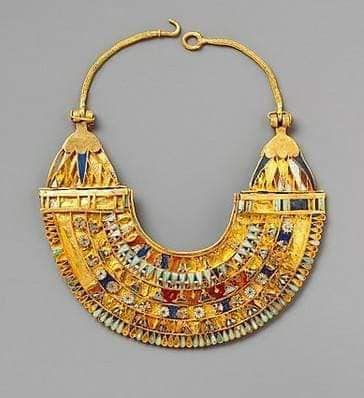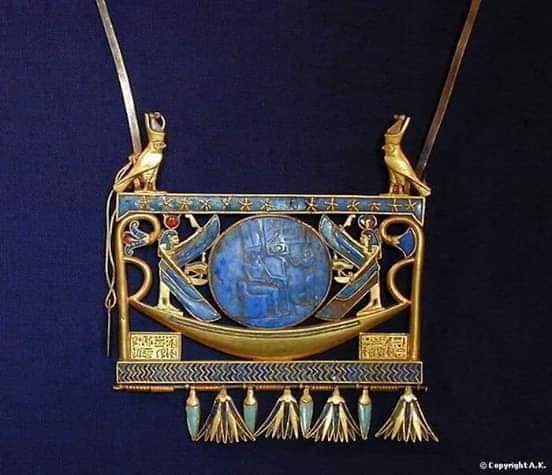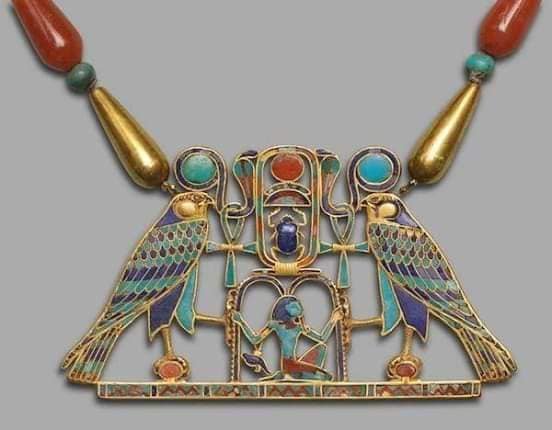The woman is the first lover of decoration throughout the ages, so she mastered the drafters of the jewellers, incited to satisfy her creative taste, and competed in the creation of her new artisans.
The Egyptian woman became famous for her love of jewellery and jewellery, and the men also wore jewellery with women, as they had evidence of their owner's wealth, in addition to beautifying and decorating his image in front of society.
He described the branches of plants, seashells, hard stones, and bones, which are the first materials used by the ancient Egyptian in making jewellery, and that was in relation to El-Badary and Naqada era, that is, in prehistoric times.
The ancient Egyptian used to collect these artefacts, through flax or cow hair and worked on painting them with glass materials for a bright export, which would give them more acceptance.
Then the jewellery industry developed over time as the first "Pharaonic family". The ancient Egyptian gained the ability to make jewellery from precious and semi-precious stones, and some minerals such as gold and silver.
The gold jewellery industry also flourished so much that it reached its peak during the middle and modern countries, so the accuracy of the ancient Egyptian goldsmith appeared in creating an impressive array of high-end gold craftsmanship in an unprecedented way, which loves the overload of missions that extract the minerals. Which was fed with many types of precious stones known in Egypt; including inlays of gold and silver with agate and turquoise?
Pharaonic women were not only across different families who used jewellery for happy occasions, but it went beyond that to their use in general in daily life. It is strange that the ancient Egyptians were keen to keep a large dimension of jewellery inside their tombs, and large numbers of them were found from: "wreaths, crowns, or collars of natural and false hair, and various types of cosmetic trinkets, such as small rosettes, golden hoops, Easy ribbons of jewellery.
Among the types of famous jewellery: those bracelets, anklets, rings, necklaces, and belts that were worn by both women and men, such as waist belts, and belts hanging from them with vertical straps. The pectoralis also one of the most important types of jewellery that did not appear except in the ancient Egyptian civilization, which is a jewellery worn on the chest square, rectangular or trapezoidal shape, and was attached to a thread with beads, and among the most important bras that are known from the era of the Middle Kingdom about (1900 BC) Made of gold and set with semi-precious stones, such as (Lamathist) stone, brown agate, feldspar, lapis lazuli, turquoise, rock crystal, and Obsidian.
The Egyptian jeweller also decorated the vests with the symbols and names of the kings, believing that they were a guarantee of prosperity, life or permanence, according to what is indicated by the inscribed form on them.
The bra was also made of gold, sometimes of gold-plated metal. It is also painted yellow if it is made of less metal, such as copper or other, to take the form of gold, and what are the girls in the Egyptian countryside wearing the bra so far, even if the bra is another name; it is "gold card".
The colours inlaid with the jewellery had meaning for their beliefs. An example of blue represents protection from evil or envious eye, and the green colour overflows with rest and vitality and brings back youth. As for the scarab, made of green or blue faience, or semi-precious stones. Finally, the ancients believed that the exercise they wore in the bras for the purpose of protection and guarding, and was worn in the organs believed to have been exposed to dangers, such as the neck, wrist, and joint, Fingers and middle.
Scientists are still the most popular jewellery yet. They are worn in the wrist, and it was one of the most beautiful fences that were found in the tombs of the twelfth princesses of the family, and women still adorn them.
As for anklets, they are worn in the foot. The ancient Egyptian knew the wreaths and the anklets since prehistoric times, and it was made of materials such as bone, wood, skin and hair, then worked beads in the threads of the system, and these beads were made and were studded with semi-precious stones or glass, and may be used In everyday life, it is dark or decorative for their adornment, or they are placed with the deceased in the burial chamber, or they are depicted on the walls or on the surfaces of the coffins, or the deceased wears it himself.
A headwear made of tree wreaths and flower buds also spread. Strips of cloth were used to tie the hair as an ornament, or so as not to obstruct the vision at work, and then made wigs and hoods as a wig from linen braid, sometimes from real wool or hair, and decorated gold rosettes inlaid with semi-precious stones, or with stained glass like the wreaths that wore them The wife of Rahotep, or the daughters of Khanohotep.






















No comments:
Post a Comment
excellent go-ahead